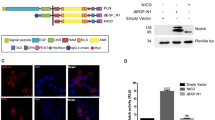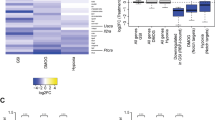Abstract
The Notch pathway is a short-range signaling mechanism between neighboring cells that results in changes in gene expression. Extracellular interactions between Notch receptors and ligands trigger proteolytic cleavage of the receptor Notch. Following cleavage, the freed intracellular domain of Notch (NotchIC) moves from the cytoplasm to the nucleus, engaging the DNA-binding transcription factor CBF-1, Su(H), Lag-1 (CSL)—the nuclear effector of the pathway. NotchIC, together with the transcriptional coactivator Mastermind, form a ternary complex with CSL that activates transcription from genes that are responsive to Notch signaling. Illuminating the molecular details that underlie formation of the transcriptionally active CSL–NotchIC–Mastermind ternary complex is key for understanding how genes are turned on in response to a Notch signal. Recently, several studies using biophysical and computational methods have scrutinized how the CSL–NotchIC–Mastermind ternary complex forms and the role individual domains play in this process. These detailed analyses have provided a wealth of molecular insights into the assembly of a Notch pathway active transcription complex but have also raised several intriguing, yet confounding questions. This review will focus on the findings of these recent biophysical studies and provide speculative models that address these unanswered questions.
This is a preview of subscription content, access via your institution
Access options
Subscribe to this journal
Receive 50 print issues and online access
$259.00 per year
only $5.18 per issue
Buy this article
- Purchase on Springer Link
- Instant access to full article PDF
Prices may be subject to local taxes which are calculated during checkout




Similar content being viewed by others
References
Artavanis-Tsakonas S, Rand MD, Lake RJ . (1999). Notch signaling: cell fate control and signal integration in development. Science 284: 770–776.
Aster JC, Xu L, Karnell FG, Patriub V, Pui JC, Pear WS . (2000). Essential roles for ankyrin repeat and transactivation domains in induction of T-cell leukemia by notch1. Mol Cell Biol 20: 7505–7515.
Bergqvist S, Croy CH, Kjaergaard M, Huxford T, Ghosh G, Komives EA . (2006). Thermodynamics reveal that helix four in the NLS of NF-kappaB p65 anchors IkappaBalpha, forming a very stable complex. J Mol Biol 360: 421–434.
Bertagna A, Toptygin D, Brand L, Barrick D . (2008). The effects of conformational heterogeneity on the binding of the Notch intracellular domain to effector proteins: a case of biologically tuned disorder. Biochem Soc Trans 36: 157–166.
Bray S, Furriols M . (2001). Notch pathway: making sense of suppressor of hairless. Curr Biol 11: R217–R221.
Bray SJ . (2006). Notch signalling: a simple pathway becomes complex. Nat Rev Mol Cell Biol 7: 678–689.
Chiang MY, Xu ML, Histen G, Shestova O, Roy M, Nam Y et al. (2006). Identification of a conserved negative regulatory sequence that influences the leukemogenic activity of NOTCH1. Mol Cell Biol 26: 6261–6271.
Christensen S, Kodoyianni V, Bosenberg M, Friedman L, Kimble J . (1996). lag-1, a gene required for lin-12 and glp-1 signaling in Caenorhabditis elegans, is homologous to human CBF1 and Drosophila Su(H). Development 122: 1373–1383.
Delbianco C, Aster J, Blacklow S . (2008). Mutational and energetic studies of Notch1 transcription complexes. J Mol Biol 376: 131–140.
Dyson HJ, Wright PE . (2005). Intrinsically unstructured proteins and their functions. Nat Rev Mol Cell Biol 6: 197–208.
Ehebauer MT, Chirgadze DY, Hayward P, Martinez Arias A, Blundell TL .(2005). High-resolution crystal structure of the human Notch 1 ankyrin domain. Biochem J 392: 13–20.
Friedmann DR, Wilson JJ, Kovall RA . (2008). RAM-induced allostery facilitates assembly of a Notch pathway active transcription complex. J Biol Chem 283: 14781–14791.
Fryer CJ, Lamar E, Turbachova I, Kintner C, Jones KA . (2002). Mastermind mediates chromatin-specific transcription and turnover of the Notch enhancer complex. Genes Dev 16: 1397–1411.
Fryer CJ, White JB, Jones KA . (2004). Mastermind recruits CycC:CDK8 to phosphorylate the Notch ICD and coordinate activation with turnover. Mol Cell 16: 509–520.
Gridley T . (2003). Notch signaling and inherited disease syndromes. Hum Mol Genet 12 (Spec no. 1): R9–R13.
High FA, Epstein JA . (2008). The multifaceted role of Notch in cardiac development and disease. Nat Rev Genet 9: 49–61.
Hsieh JJ, Henkel T, Salmon P, Robey E, Peterson MG, Hayward SD . (1996). Truncated mammalian Notch1 activates CBF1/RBPJk-repressed genes by a mechanism resembling that of Epstein-Barr virus EBNA2. Mol Cell Biol 16: 952–959.
Jacobs MD, Harrison SC . (1998). Structure of an IkappaBalpha/NF-kappaB complex. Cell 95: 749–758.
Jeffries S, Robbins DJ, Capobianco AJ . (2002). Characterization of a high-molecular-weight Notch complex in the nucleus of Notch(ic)-transformed RKE cells and in a human T-cell leukemia cell line. Mol Cell Biol 22: 3927–3941.
Kimble J, Crittenden SL . (2007). Controls of germline stem cells, entry into meiosis, and the sperm/oocyte decision in Caenorhabditis elegans. Annu Rev Cell Dev Biol 23: 405–433.
Koch U, Radtke F . (2007). Notch and cancer: a double-edged sword. Cell Mol Life Sci 64: 2746–2762.
Kovall RA, Hendrickson WA . (2004). Crystal structure of the nuclear effector of Notch signaling, CSL, bound to DNA. EMBO J 23: 3441–3451.
Krissinel E, Henrick K . (2007). Inference of macromolecular assemblies from crystalline state. J Mol Biol 372: 774–797.
Kurooka H, Honjo T . (2000). Functional interaction between the mouse notch1 intracellular region and histone acetyltransferases PCAF and GCN5. J Biol Chem 275: 17211–17220.
Kurooka H, Kuroda K, Honjo T . (1998). Roles of the ankyrin repeats and C-terminal region of the mouse notch1 intracellular region. Nucleic Acids Res 26: 5448–5455.
Lai EC . (2002). Keeping a good pathway down: transcriptional repression of Notch pathway target genes by CSL proteins. EMBO Rep 3: 840–845.
Lubman OY, Ilagan MX, Kopan R, Barrick D . (2007). Quantitative dissection of the Notch:CSL interaction: insights into the Notch-mediated transcriptional switch. J Mol Biol 365: 577–589.
Lubman OY, Kopan R, Waksman G, Korolev S . (2005). The crystal structure of a partial mouse Notch-1 ankyrin domain: repeats 4 through 7 preserve an ankyrin fold. Protein Sci 14: 1274–1281.
Miele L, Golde T, Osborne B . (2006). Notch signaling in cancer. Curr Mol Med 6: 905–918.
Mosavi LK, Cammett TJ, Desrosiers DC, Peng ZY . (2004). The ankyrin repeat as molecular architecture for protein recognition. Protein Sci 13: 1435–1448.
Mumm JS, Kopan R . (2000). Notch signaling: from the outside in. Dev Biol 228: 151–165.
Nam Y . (2003). Structural requirements for assembly of the CSL·Intracellular Notch1·Mastermind-like 1 transcriptional activation complex. J Biol Chem 278: 21232–21239.
Nam Y, Sliz P, Song L, Aster J, Blacklow S . (2006). Structural basis for cooperativity in recruitment of MAML coactivators to Notch transcription complexes. Cell 124: 973–983.
Nam Y, Weng AP, Aster JC, Blacklow SC . (2003). Structural requirements for assembly of the CSL·intracellular Notch1·Mastermind-like 1 transcriptional activation complex. J Biol Chem 278: 21232–21239.
Petcherski AG, Kimble J . (2000a). LAG-3 is a putative transcriptional activator in the C. elegans Notch pathway. Nature 405: 364–368.
Petcherski AG, Kimble J . (2000b). Mastermind is a putative activator for Notch. Curr Biol 10: R471–R473.
Roehl H, Bosenberg M, Blelloch R, Kimble J . (1996). Roles of the RAM and ANK domains in signaling by the C. elegans GLP-1 receptor. EMBO J 15: 7002–7012.
Ruas JL, Lendahl U, Poellinger L . (2007). Modulation of vascular gene expression by hypoxia. Curr Opin Lipidol 18: 508–514.
Tamura K, Taniguchi Y, Minoguchi S, Sakai T, Tun T, Furukawa T et al. (1995). Physical interaction between a novel domain of the receptor Notch and the transcription factor RBP-J kappa/Su(H). Curr Biol 5: 1416–1423.
Tanigaki K, Honjo T . (2007). Regulation of lymphocyte development by Notch signaling. Nat Immunol 8: 451–456.
Wallberg AE, Pedersen K, Lendahl U, Roeder RG . (2002). p300 and PCAF act cooperatively to mediate transcriptional activation from chromatin templates by notch intracellular domains in vitro. Mol Cell Biol 22: 7812–7819.
Weng AP, Ferrando AA, Lee W, Morris JPt, Silverman LB, Sanchez-Irizarry C et al. (2004). Activating mutations of NOTCH1 in human T cell acute lymphoblastic leukemia. Science 306: 269–271.
Wilson JJ, Kovall RA . (2006). Crystal structure of the CSL–Notch–Mastermind ternary complex bound to DNA. Cell 124: 985–996.
Wu L, Aster JC, Blacklow SC, Lake R, Artavanis-Tsakonas S, Griffin JD . (2000). MAML1, a human homologue of Drosophila mastermind, is a transcriptional co-activator for NOTCH receptors. Nat Genet 26: 484–489.
Zhou S, Hayward SD . (2001). Nuclear localization of CBF1 is regulated by interactions with the SMRT corepressor complex. Mol Cell Biol 21: 6222–6232.
Zweifel ME, Leahy DJ, Hughson FM, Barrick D . (2003). Structure and stability of the ankyrin domain of the Drosophila Notch receptor. Protein Sci 12: 2622–2632.
Acknowledgements
I thank the members of my laboratory for the stimulating discussions regarding Notch signaling, which spurred the writing of this review. In particular, I thank Jeffrey Wilson and David Friedmann for editing the manuscript and assistance with creation of the figures. I am also very grateful for the biophysical expertise and constructive criticism provided by my departmental colleagues Andrew Herr and Tom Thompson. This work was supported by grants from the NIH and the University of Cincinnati Barrett Cancer Center.
Author information
Authors and Affiliations
Corresponding author
Rights and permissions
About this article
Cite this article
Kovall, R. More complicated than it looks: assembly of Notch pathway transcription complexes. Oncogene 27, 5099–5109 (2008). https://doi.org/10.1038/onc.2008.223
Published:
Issue Date:
DOI: https://doi.org/10.1038/onc.2008.223
Keywords
This article is cited by
-
The evolution of transcriptional repressors in the Notch signaling pathway: a computational analysis
Hereditas (2019)
-
Transcription factor Ptf1a in development, diseases and reprogramming
Cellular and Molecular Life Sciences (2019)
-
Rbpj direct regulation of Atoh7 transcription in the embryonic mouse retina
Scientific Reports (2018)
-
Notch signaling pathway and gene expression profiles during early in vitro differentiation of liver-derived mesenchymal stromal cells to osteoblasts
Laboratory Investigation (2017)
-
Desmoid-Type Fibromatosis: Who, When, and How to Treat
Current Treatment Options in Oncology (2017)



